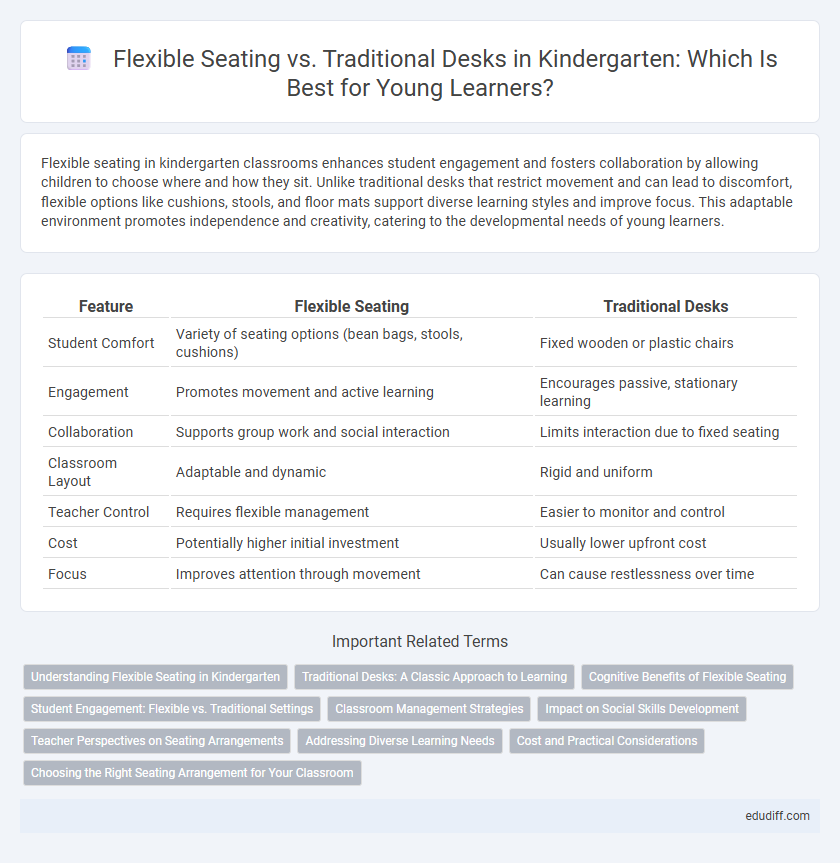Flexible seating in kindergarten classrooms enhances student engagement and fosters collaboration by allowing children to choose where and how they sit. Unlike traditional desks that restrict movement and can lead to discomfort, flexible options like cushions, stools, and floor mats support diverse learning styles and improve focus. This adaptable environment promotes independence and creativity, catering to the developmental needs of young learners.
Table of Comparison
| Feature | Flexible Seating | Traditional Desks |
|---|---|---|
| Student Comfort | Variety of seating options (bean bags, stools, cushions) | Fixed wooden or plastic chairs |
| Engagement | Promotes movement and active learning | Encourages passive, stationary learning |
| Collaboration | Supports group work and social interaction | Limits interaction due to fixed seating |
| Classroom Layout | Adaptable and dynamic | Rigid and uniform |
| Teacher Control | Requires flexible management | Easier to monitor and control |
| Cost | Potentially higher initial investment | Usually lower upfront cost |
| Focus | Improves attention through movement | Can cause restlessness over time |
Understanding Flexible Seating in Kindergarten
Flexible seating in kindergarten promotes student engagement by offering diverse seating options like floor cushions, wobble stools, and bean bags that accommodate various learning styles and physical needs. This approach fosters collaboration, enhances focus, and supports movement, contrasting with traditional desks that limit mobility and often constrain student interaction. Research shows that flexible seating can improve classroom behavior and increase student comfort, leading to a more dynamic and inclusive learning environment.
Traditional Desks: A Classic Approach to Learning
Traditional desks in kindergarten offer structured seating that helps young learners develop focus and discipline. This classic approach provides individual space for writing, drawing, and hands-on activities, fostering a sense of personal responsibility. Educators find traditional desks effective for classroom management and organized learning environments.
Cognitive Benefits of Flexible Seating
Flexible seating in kindergarten enhances cognitive development by promoting autonomy, improving focus, and encouraging active engagement. Environments with varied seating options like wobble stools, cushions, and standing desks support different learning styles and sensory needs, leading to better information retention. Research indicates that flexible seating fosters executive function skills including self-regulation, working memory, and cognitive flexibility, which are critical for early childhood learning success.
Student Engagement: Flexible vs. Traditional Settings
Flexible seating in kindergarten classrooms increases student engagement by allowing children to choose learning spaces that suit their comfort and attention needs, promoting autonomy and collaboration. Traditional desks, while structured, often limit movement and interaction, potentially reducing sustained focus and enthusiasm during lessons. Research indicates that flexible seating fosters active participation and social skills development, enhancing overall engagement compared to traditional seating arrangements.
Classroom Management Strategies
Flexible seating in kindergarten classrooms fosters student autonomy and engagement by allowing children to choose comfortable, dynamic seating options that promote movement and collaboration. Traditional desks offer structure and routine, simplifying behavior monitoring and reducing distractions by providing clear personal space for each student. Effective classroom management strategies balance flexibility with clear expectations to optimize focus and encourage positive social interactions.
Impact on Social Skills Development
Flexible seating in kindergarten classrooms encourages collaboration, communication, and peer interaction, fostering stronger social skills development compared to traditional desks. Children engaging in group activities on cushions, bean bags, or floor seating naturally practice sharing, turn-taking, and conflict resolution. Research shows this dynamic environment enhances empathy and cooperation, key components of early social growth.
Teacher Perspectives on Seating Arrangements
Teachers observe that flexible seating in kindergarten classrooms enhances student engagement and collaboration by allowing children to choose comfortable spots that meet their learning preferences. Traditional desks provide structure and ease of classroom management, but may limit movement and creativity among young learners. Educators emphasize that flexible seating supports diverse learning styles and promotes autonomy, which can lead to improved focus and behavior.
Addressing Diverse Learning Needs
Flexible seating in kindergarten classrooms enhances student engagement by accommodating varied learning styles and sensory preferences, unlike traditional desks that restrict movement and interaction. Incorporating options such as floor cushions, wobble stools, and standing desks allows children to choose seating that best supports their focus and comfort, promoting individualized learning. This adaptable environment supports social collaboration and improves behavior by meeting diverse developmental and physical needs.
Cost and Practical Considerations
Flexible seating often reduces costs by minimizing the need for individual desks and allowing multipurpose furniture, which can be more budget-friendly for kindergartens. Traditional desks, while possibly more expensive upfront due to their quantity and durability requirements, offer consistent organization and predictable classroom management. Practical considerations include the ease of cleaning and rearranging flexible seating compared to the fixed nature of traditional desks, impacting daily maintenance and classroom dynamics.
Choosing the Right Seating Arrangement for Your Classroom
Flexible seating options in kindergarten classrooms boost student engagement and accommodate various learning styles, promoting collaboration with movable chairs, cushions, and floor spots. Traditional desks provide structure and individual focus but may limit mobility and interaction among young learners. Selecting the right seating arrangement depends on classroom goals, student needs, and the balance between order and creativity to enhance comfort and productivity.
Flexible seating vs Traditional desks Infographic

 edudiff.com
edudiff.com